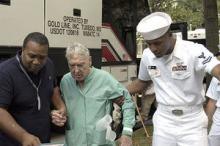CHICAGO – One in three elderly veterans required discharge to an institutional care facility following major elective surgery in a prospective cohort study of 223 patients.
The chance of being discharged to an institution rose dramatically from 5% if an individual patient had 0 to 1 frailty traits to 21% with 2 or 3 traits, 76% with 4 or 5 traits, and 89% with 6 or 7 traits, lead author Dr. Thomas Robinson said at the annual meeting of the Western Surgical Association.
The comparisons were significant at a P value of .01, except for the 4 or 5 traits vs. 6 or 7 traits (P = .31).
On the basis of their research, Dr. Robinson and his colleagues are developing a preoperative frailty score that surgeons can use when counseling their patients.
"We have a standardized sheet that can be put up on the clinic door, and the surgeon can walk up and review the sheet and understand the burden of frailty of an individual patient and counsel them appropriately," he said.
The 223 veterans in the study had to be at least 65 years old, and their average age was 73. The majority were male (96%), and all had lived at home before undergoing an elective major operation requiring postoperative ICU admission at the Denver Veterans Affairs Medical Center. Surgical specialties included general, thoracic, vascular, and urology.
As shown in a univariate analysis, patients discharged to institutional care were significantly older than those who went home (77 vs. 72 years), and significantly more likely to have any functional dependence (76% vs. 16%), a get-up-and-go test time of at least 15 seconds (67% vs. 8%), a Charlson comorbidity index of 3 or more (86% vs. 42%), increased American Society of Anesthesiologists score (3.0 vs. 2.8), a hematocrit less than 35% (44% vs. 6%), an albumin less than 3.4 g/dL (66% vs. 10%), a Mini-Cog score of 3 or less, and at least one fall in the prior 6 months (61% vs. 17%).
The number of medications, body mass index, weight loss, and depression were not significantly associated with discharge institutionalization, said Dr. Robinson of the University of Colorado at Denver.
Intraoperative variables including length of operation, blood loss, transfusion, and type of surgery were also similar between groups.
On logistic regression analysis, two frailty characteristics were found to be most closely related to discharge to an institutional care facility: prolonged time on the get-up-and-go test of 15 seconds or more (odds ratio 13.0, P value less than .0001) and dependence in one or more activities of daily living (OR 5.7, P less than .0001), he said. The get-up-and-go test measures the time needed to rise unassisted from a chair, walk several feet, and return to the chair.
Mean length of institutional stay at a nursing home, skilled nursing facility, or rehabilitation facility was 25 days (range, 3-112 days).
During a discussion of the study, Dr. Charles Scoggins of the University of Louisville (Ky.), asked whether the score predicts postoperative complications.
"Yes, they absolutely do," responded Dr. Robinson. "We have groups of cardiac patients that were scored in complications and then validated in colorectal operations. I’d go one step further and say that frailty across surgical specialties can predict postoperative outcomes whether they be complications, dispensation to an institutional care facility, [or] in our previous paper, 6-month mortality."
In that study, the accumulation of four frailty markers predicted 6-month mortality with a sensitivity of 81% and specificity of 86%. In addition, the functional frailty characteristic of dependence in one or more activities of daily living was found to be most closely related to 6-month mortality, a finding reinforced by the current study. (Ann. Surg. 2009;250:338-47).
Invited discussant Dr. Travis Webb of the Medical College of Wisconsin, Milwaukee, said that increasing evidence points to factors beyond simple age as predictors of mortality, morbidity, and the need for skilled nursing care in the posthospitalization time period. He observed that the need for accurate information on these predictors will become increasingly important as the number of elderly surgery patients swells. It is estimated that 55% of all operations in the United States are being performed on patients aged 65 years and older.
Dr. Webb pointed out, however, that limiting the study to patients requiring ICU admission limits the generalizability of the results and asked whether surgeons or primary care providers should best screen patients for frailty. Dr. Robinson said screening is particularly valuable if done in the operative clinic and that screening results have changed the decision to have surgery, the scope of the surgery, and patient and family expectations.

